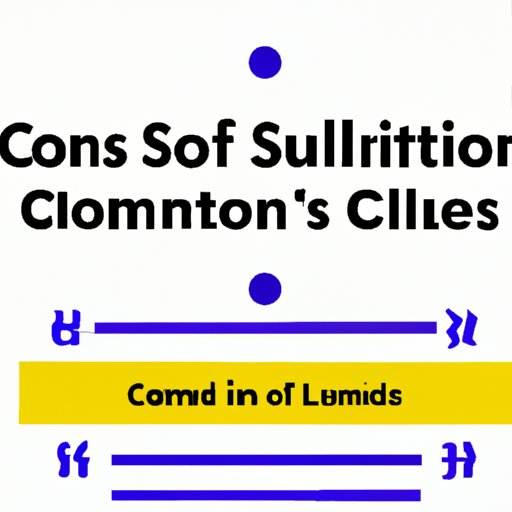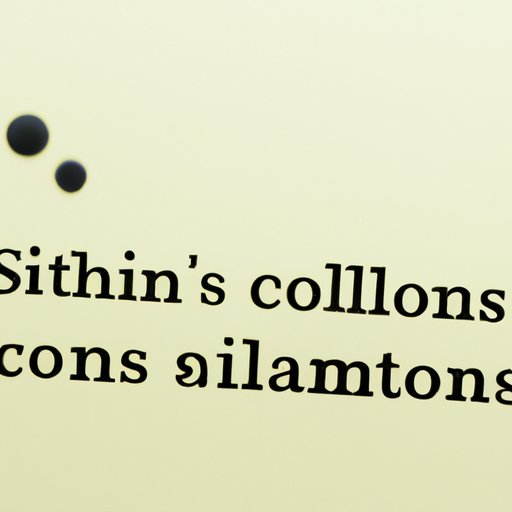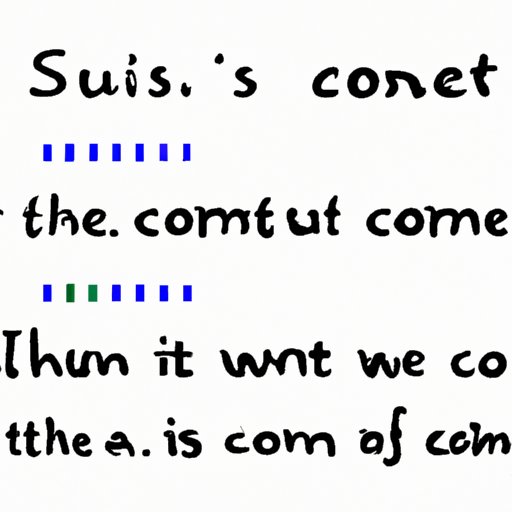Introduction
A semicolon is one of the most important punctuation marks used in English writing. It is used to separate two independent clauses, or to join together two related ideas in a single sentence. In this article, we’ll explore what a semicolon is and how to use it correctly in your writing.

A Comprehensive Guide to Understanding Semicolons in Writing
What is a semicolon?
A semicolon is a punctuation mark used to indicate a pause between two independent clauses. It looks like a combination of a period (or full stop) and a comma, and is typically used in formal writing. The purpose of a semicolon is to make clear the relationship between two independent clauses, which are two complete sentences that can stand alone but are related to each other. For example, you could use a semicolon to connect two related sentences such as “I love ice cream; it’s my favorite dessert.”
What is the purpose of a semicolon?
The primary purpose of a semicolon is to join together two independent clauses that are closely related in meaning. It is also used to separate items in a list, when the items themselves contain commas. For example, you can use a semicolon to separate the items in a list such as “I bought apples, oranges, and bananas; pears, peaches, and plums; and grapes and strawberries.”
How do you use a semicolon correctly?
Using a semicolon correctly requires an understanding of grammar rules and punctuation conventions. You should always use a semicolon to separate two independent clauses that are closely related in meaning. You should also use a semicolon to separate items in a list when the items themselves contain commas. Additionally, you can use a semicolon to emphasize a phrase or clause, or to separate multiple phrases or clauses that are connected by conjunctions.

The Basics of the Semicolon: What You Need to Know
Types of sentences that require a semicolon
Semicolons are commonly used to separate two independent clauses that are closely related in meaning. This means that the two clauses must both be able to stand on their own as complete sentences. For example, you can use a semicolon to separate two related sentences such as “I love ice cream; it’s my favorite dessert.”
How to punctuate lists with semicolons
When creating a list of items that contain commas, you can use semicolons to separate the items in the list. For example, you can use a semicolon to separate the items in a list such as “I bought apples, oranges, and bananas; pears, peaches, and plums; and grapes and strawberries.”
Other uses of semicolons
In addition to being used to separate two independent clauses and punctuate lists, semicolons can also be used to emphasize a phrase or clause, or to separate multiple phrases or clauses that are connected by conjunctions. For example, you could use a semicolon to emphasize a phrase such as “I’m going to try; really hard.” Or you could use a semicolon to separate multiple phrases or clauses connected by conjunctions such as “I’m going to the store; and then I’m going to the park.”

How to Use Semicolons Correctly in Your Writing
Grammar rules for using semicolons
When using semicolons in your writing, there are some basic grammar rules that you should follow. First, make sure that the two clauses that you are separating with a semicolon are both complete sentences. Second, make sure that the two clauses are closely related in meaning. Third, make sure that the two clauses are not joined by a coordinating conjunction (such as “and,” “but,” “or,” “so,” etc.). Fourth, make sure that the two clauses are not joined by a subordinating conjunction (such as “because,” “although,” “after,” etc.). Finally, make sure that the two clauses are not separated by a comma.
Examples of how to use semicolons in sentences
To help you understand how to use semicolons correctly in your writing, here are some examples of correct usage:
- “I love ice cream; it’s my favorite dessert.”
- “I bought apples, oranges, and bananas; pears, peaches, and plums; and grapes and strawberries.”
- “I’m going to try; really hard.”
- “I’m going to the store; and then I’m going to the park.”
When to Use a Semicolon: Rules and Examples
Common situations where semicolons should be used
When deciding when to use a semicolon in your writing, there are some common situations that you should keep in mind. First, you should use a semicolon to separate two independent clauses that are closely related in meaning. Second, you should use a semicolon to separate items in a list when the items themselves contain commas. Third, you should use a semicolon to emphasize a phrase or clause, or to separate multiple phrases or clauses that are connected by conjunctions.
Examples of when semicolons are appropriate
Here are some examples of when it is appropriate to use a semicolon in your writing:
- “I love ice cream; it’s my favorite dessert.”
- “I bought apples, oranges, and bananas; pears, peaches, and plums; and grapes and strawberries.”
- “I’m going to try; really hard.”
- “I’m going to the store; and then I’m going to the park.”
Mastering the Art of the Semicolon: Tips and Tricks for Writers
Strategies for mastering semicolon usage
Once you have a basic understanding of grammar rules and punctuation conventions, there are some strategies that you can use to become more proficient at using semicolons in your writing. First, practice using semicolons in your writing. Second, read through your writing and look for opportunities to use semicolons. Third, if you aren’t sure whether or not to use a semicolon, consider replacing the semicolon with a period or a comma and see if it changes the meaning of the sentence.
Tips for avoiding common mistakes
Finally, here are some tips for avoiding common mistakes when using semicolons in your writing:
- Don’t use a semicolon to separate two independent clauses that are not closely related in meaning.
- Don’t use a semicolon to separate two independent clauses that are joined by a coordinating conjunction.
- Don’t use a semicolon to separate two independent clauses that are separated by a comma.
- Don’t use a semicolon to separate two independent clauses that are separated by a subordinating conjunction.
Conclusion
In conclusion, a semicolon is an important punctuation mark used to separate two independent clauses, or to join together two related ideas in a single sentence. It is important to understand the grammar rules and punctuation conventions associated with using a semicolon in order to use it correctly in your writing. With practice and a few simple strategies, you can master the art of the semicolon and use it correctly in your writing.
(Note: Is this article not meeting your expectations? Do you have knowledge or insights to share? Unlock new opportunities and expand your reach by joining our authors team. Click Registration to join us and share your expertise with our readers.)
